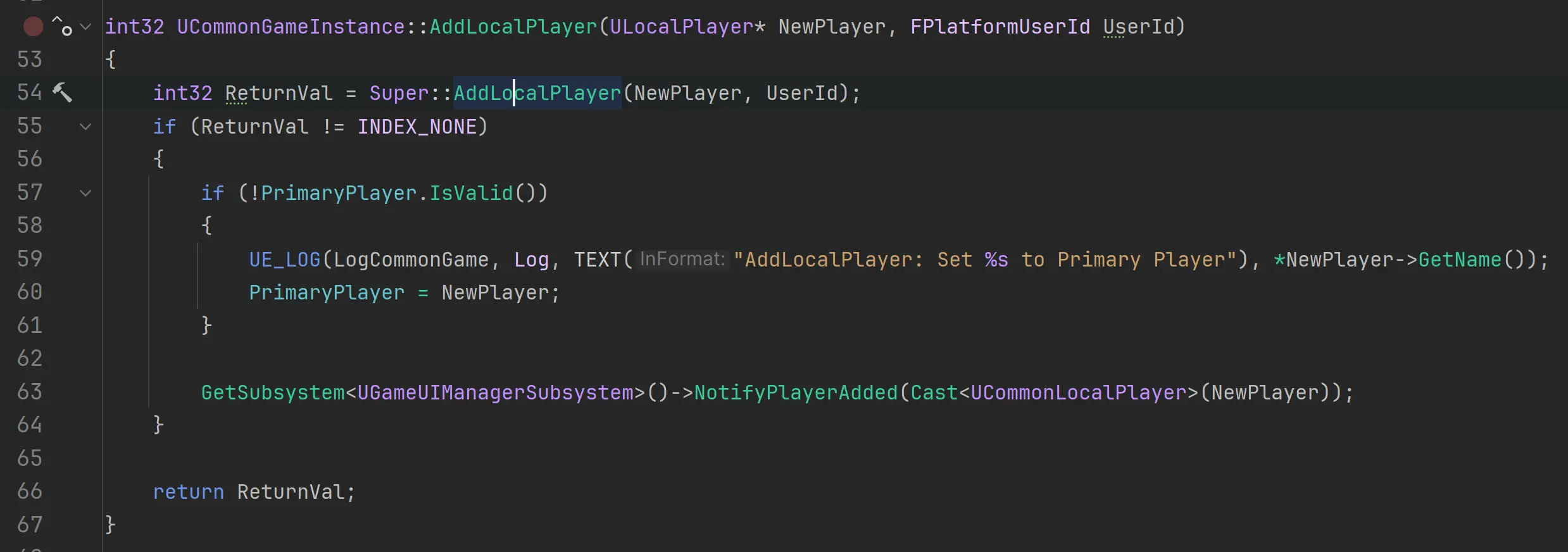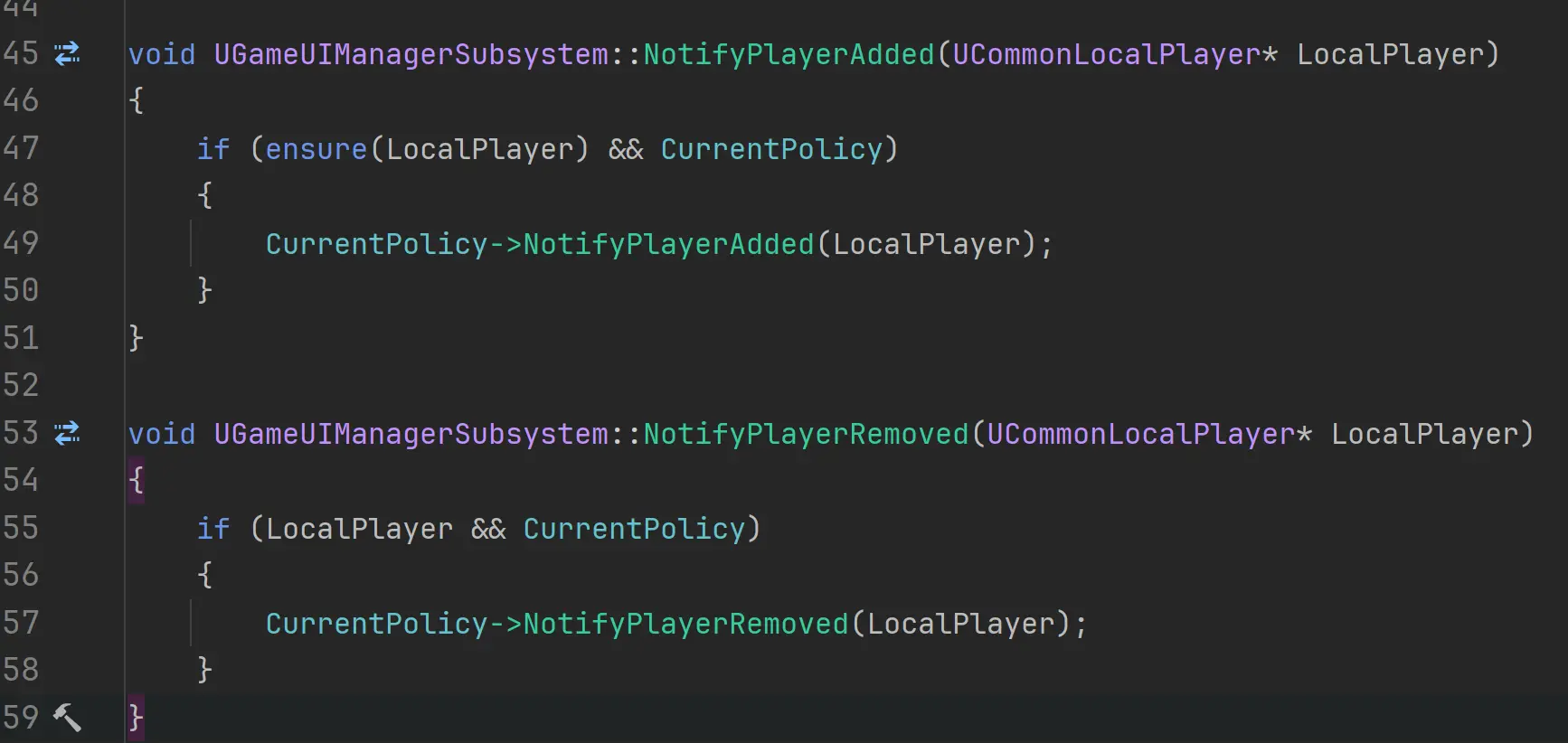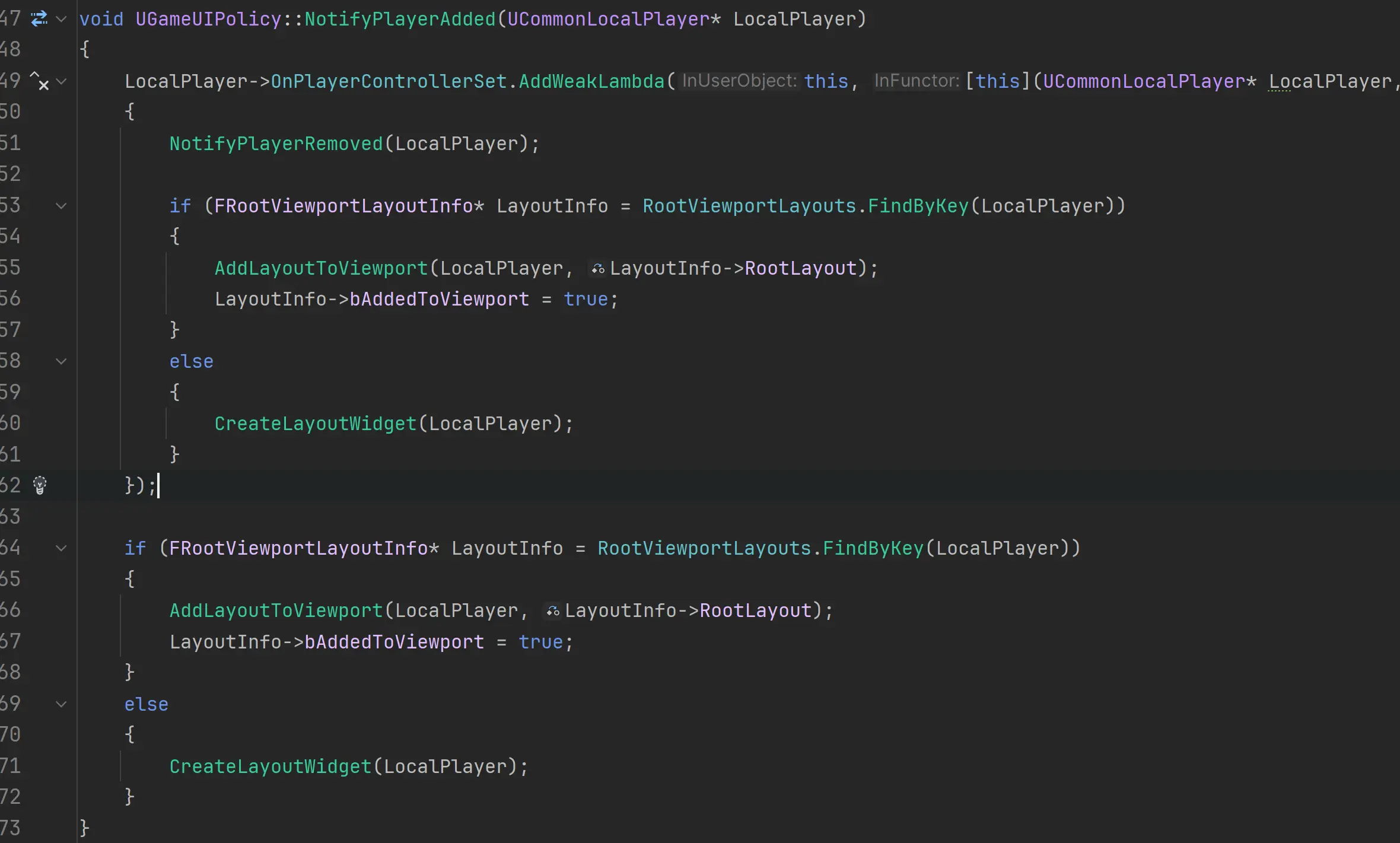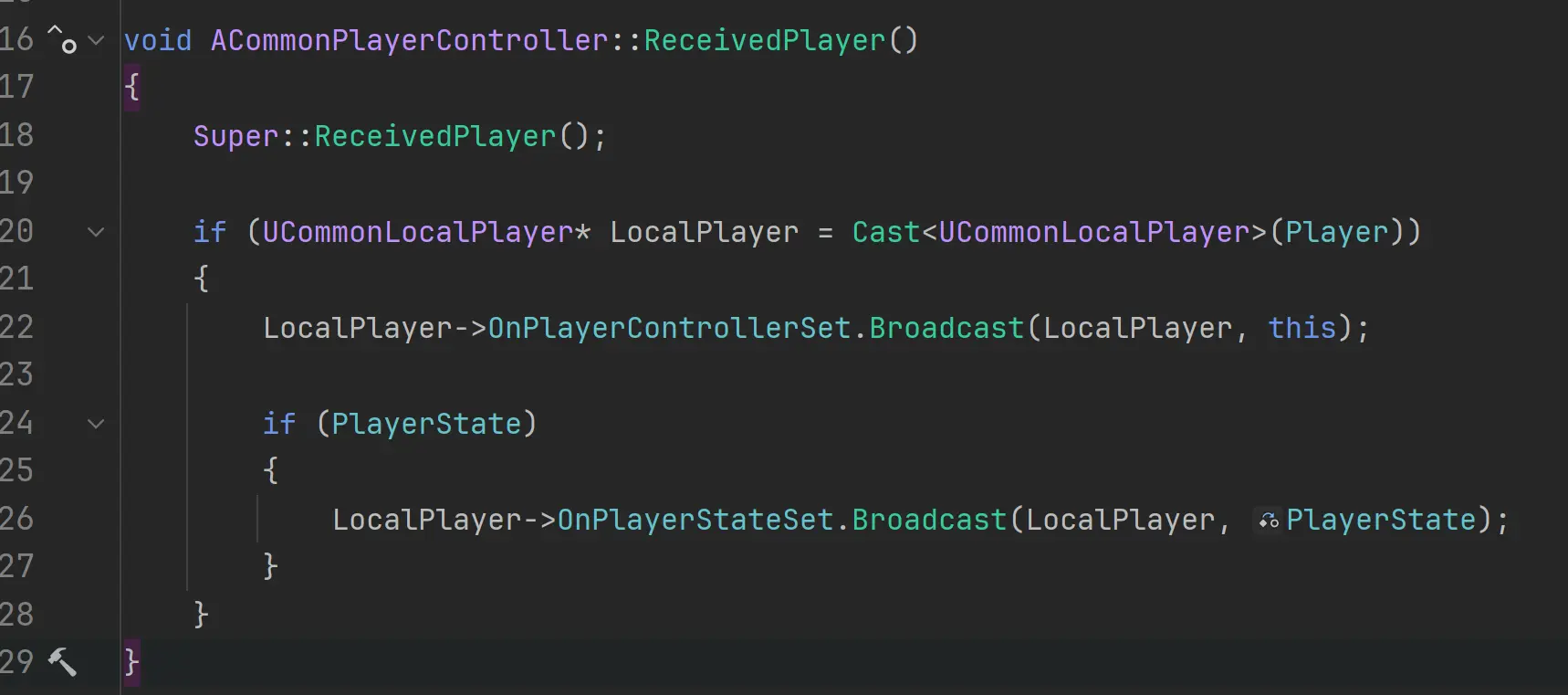Lyra Common Game Dialog
Lyra Game Dialog 的代码设计上看,它是一个为多人同屏设计的,类似双人成行那种同个屏幕,双人游玩。
大部分代码来自CommonGame 模块,而CommonGame 又需要引用CommonUser 模块 和 ModularGameplayActors 模块。
所以使用Lyra的Dialog,需要引用CommonGame,CommonUser,ModularGameplayActors这三个模块。
根布局添加过程
1. UCommonGameInstance
- 通过CommonGame 的 CommonGameInstance 通知新LocalPlayer 加入

- 告知 UGameUIManagerSubsystem
2. UGameUIManagerSubsystem
这个类目前在我看来,有些鸡肋。可能需要一个管理全部布局的“层”做准备。
- UGameUIManagerSubsystem 用于管理 新的 LocalPlayer 的 UI

- 但它只负责管理,不负责实现,具体功能都在 UGameUIPolicy 里面。
- 需要配置 UGameUIPolicy 的蓝图子类。
3. UGameUIPolicy
- UGameUIPolicy 会给 LocalPlayer 注册一个OnPlayerControllerSet监听

- NotifyPlayerAdded 的意思是,新的LocalPlayer 加入,会去RootViewportLayouts数组里查找,没有就创建一个。
- FindByKey的原理是:
bool operator==(const ULocalPlayer* OtherLocalPlayer) const { return LocalPlayer == OtherLocalPlayer; } - PlayerController 接收到控制器时:

- 最终,创建的Widget一定是
UPrimaryGameLayout的子类,这里的LayoutClass是需要配置的项。
4. UPrimaryGameLayout
PrimaryGameLayout 就是每个本地玩家的根布局,它提供Stack, 至于用多少层Stack,由开发者自己决定。关于Stack, 详见这里
自此,每个本地玩家都会有一个RootLayout
5.Lyra的 UGameUIManagerSubsystem
Lyra的 UGameUIManagerSubsystem 子类还做了一件事,每次tick 都检查要不要隐藏根布局。这里大概就是告诉开发者,用它可以做最顶层UI的事情。
弹出对话框
1. UAsyncAction_ShowConfirmation
Lyra 的弹窗是通过异步Action 来进行的。。
这个异步本质上是查找本地玩家并获得它的消息系统,并不是实现弹窗。
- Lyra 弹窗采取的是异步操作,UAsyncAction_ShowConfirmation继承UBlueprintAsyncActionBase
- 这个异步里,会用各种方式尝试获得对应的LocalPlayer
- 然后通过LocalPlayer获得UCommonMessagingSubsystem
- 最终调用UCommonMessagingSubsystem的ShowConfirmation

2. UCommonMessagingSubsystem
这是个子系统,实际上是个接口,它提供了ShowConfirmation这类方法的空实现。具体实现需要开发者继承它。其中FCommonMessagingResultDelegate 这个回调也被传递进来, 用于告知异步操作的结果。该消息子系统也不是弹出的具体实现位置,它只负责创建布局。先获得对应的根布局,也就是之前创建的UPrimaryGameLayout,然后实例化弹窗的Widget,把它push到根布局的Stack里面。
- 子系统是最外层自动实例化的,所以不需要手动实例化。
- 需要开发者配置 弹窗的Widget的class,必须继承于
UCommonGameDialog. - 获取根布局,并传入Dialog构造器
UCommonGameDialogDescriptor和委托:
3. UCommonGameDialogDescriptor
弹窗构造器,包含Header,Body 还有Action数组(也就是按钮数组)。
- FConfirmationDialogAction,定义按钮类型是确定还是取消,还用按钮的Label
- 默认提供了4个弹窗类型构造方法。
4. UCommonGameDialog
弹窗的真正实现,SetupDialog用于准备整个弹窗的UI。SetupDialog上面提到的UCommonMessagingSubsystem来调用。
Lyra 的实现例子:
ULyraConfirmationScreencppvoid ULyraConfirmationScreen::SetupDialog(UCommonGameDialogDescriptor* Descriptor, FCommonMessagingResultDelegate ResultCallback) { Super::SetupDialog(Descriptor, ResultCallback); Text_Title->SetText(Descriptor->Header); RichText_Description->SetText(Descriptor->Body); EntryBox_Buttons->Reset<ULyraButtonBase>([](ULyraButtonBase& Button) { Button.OnClicked().Clear(); }); for (const FConfirmationDialogAction& Action : Descriptor->ButtonActions) { FDataTableRowHandle ActionRow; switch(Action.Result) { case ECommonMessagingResult::Confirmed: ActionRow = ICommonInputModule::GetSettings().GetDefaultClickAction(); break; case ECommonMessagingResult::Declined: ActionRow = ICommonInputModule::GetSettings().GetDefaultBackAction(); break; case ECommonMessagingResult::Cancelled: ActionRow = CancelAction; break; default: ensure(false); continue; } ULyraButtonBase* Button = EntryBox_Buttons->CreateEntry<ULyraButtonBase>(); Button->SetTriggeringInputAction(ActionRow); Button->OnClicked().AddUObject(this, &ThisClass::CloseConfirmationWindow, Action.Result); Button->SetButtonText(Action.OptionalDisplayText); } OnResultCallback = ResultCallback; }Lyra动态创建了全部按钮,然后设置了委托并都绑定了同一个
CloseConfirmationWindow关闭弹窗。最后,蓝图可以根据
CloseConfirmationWindow传递过来的ECommonMessagingResult来做相应的处理。
总结
- UGameUIManagerSubsystem 负责注册,通知。
- UGameUIPolicy 配置根部布局
- UCommonMessagingSubsystem 创建Dialog
- UCommonGameDialogDescriptor 定义弹窗的内容
- UCommonGameDialog 实现弹窗内容
- UAsyncAction_ShowConfirmation 发起弹窗并广播结果
个人看法, UGameUIManagerSubsystem 内部有个 SwitchPolicy 的方法,用于切换不同的 UGameUIPolicy,也就是切换不同的根布局。然而,根布局只是一个放置不同stack的容器,即使要实现类似博德之门那种,根据键鼠和手柄切换不同的操作UI,也不是用SwitchPolicy来实现的,因为它已经是根容器,根容器本身不做任何实现,切换它没有意义。总感觉这里是设计非常冗余。
